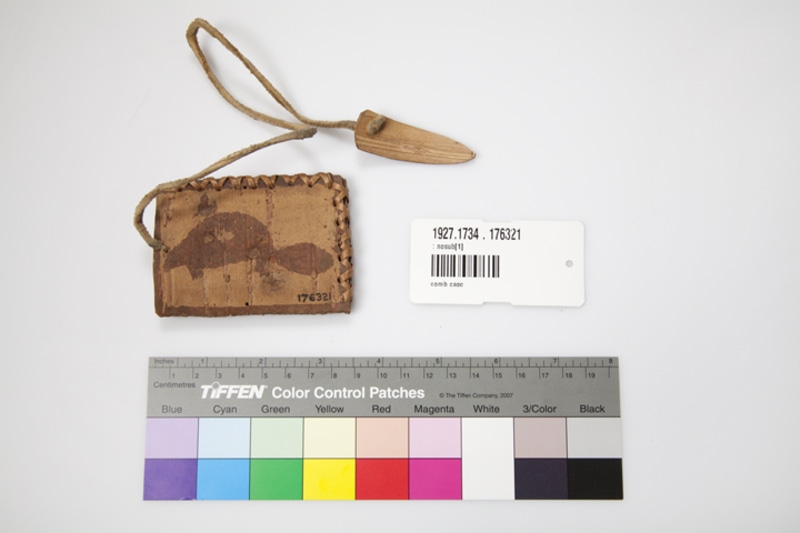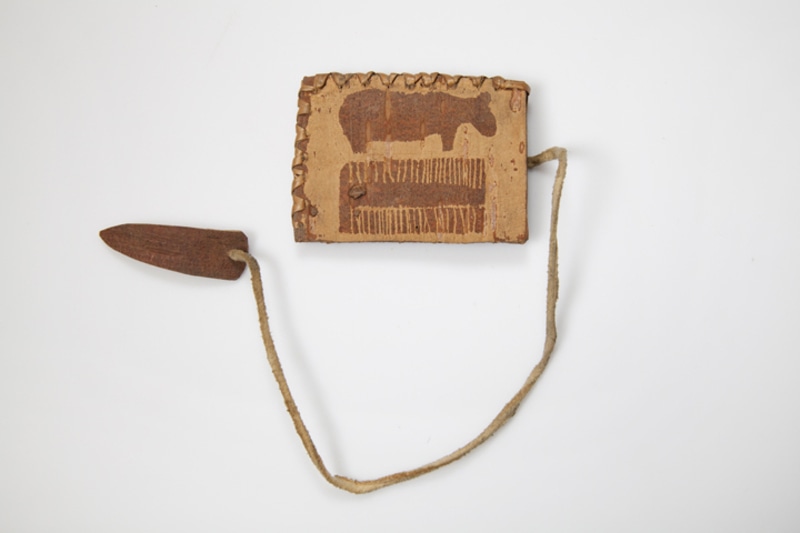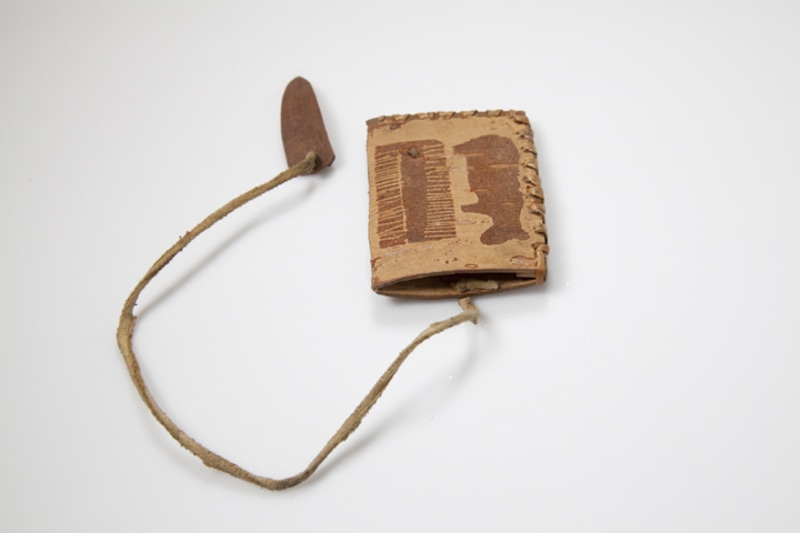comb case Item Number: 1927.1734 . 176321 from the The Field Museum




Citations From Vanstone (1982) Article
« Also decorated with positive etched patterns are two comb cases, each a single folded length of bark sewn across two sides with spruce root. Both have suspension cords of moose skin, with small triangular tabs of bark at the ends, which served as cleaners for the combs (Speck, 1937, p. 65). The smaller tab is decorated with the figure of a beaver on one side and a bear on the other (fig. 5f). The larger tab has two fish on one side and a pattern of cross-hatched lines on the other (fig. 91). » Vanstone, James W. "The Speck Collection of Montagnais Material Culture from the Lower St. Lawrence Drainage, Quebec." Fieldiana. Anthropology. New Series, No. 5 (October 29, 1982), p.9, fig 5f (p.33), fig 9l (p.37).
« Another set of nine patterns, which includes human forms, a fish, a canoe, and floral stencils, is described by Speck as having been used for bead and silk work (fig. 14). However, one of the patterns, that of a fish, was used on a previously described comb case (fig. 91).
Speck (1935, pp. 190-191) has noted that for the Montagnais, the symbolic pictorial representation of a plant or animal was equivalent to the actual plant or animal and those portrayed were believed to come under the control of the individual human spirit. Dreams played a major part in suggesting the relationship between specific animals or plants and an individual. The spirit was strengthened by having its dream promptings obeyed and success in subsistence activities was thereby assured. »
Vanstone, James W. "The Speck Collection of Montagnais Material Culture from the Lower St. Lawrence Drainage, Quebec." Fieldiana. Anthropology. New Series, No. 5 (October 29, 1982), p.10, fig 9l (p.37).
« A characteristic feature of these baskets is the presence of etched designs on tops and sides. The primary method of producing this ornamentation is by laying cut-out birch bark design patterns on the surface and scraping away the dark inner bark everywhere except where the design has been traced with the point of a knife. The positive design thus stands out dark against a light background (Speck, 1937, p. 71). »
Vanstone, James W. "The Speck Collection of Montagnais Material Culture from the Lower St. Lawrence Drainage, Quebec." Fieldiana. Anthropology. New Series, No. 5 (October 29, 1982), p.9.
Translation Of Citations From Vanstone (1982) Article
« Deux étuis à peigne sont aussi décorés avec des patrons positifs gravés, chacun formé d’un morceau d’écorce plié et cousu à travers les deux côtés avec une racine d’épinette. Les deux ont une corde en peau d’orignal, à laquelle est suspendue un petit morceau d’écorce triangulaire servant à nettoyer les peignes (Speck, 1937, p. 65). Le plus petit morceau d’écorce est décoré de la forme d’un castor sur un des côtés et d’un ours sur l’autre (fig. 5f). Le morceau le plus gros comporte deux poissons sur un côté et sur l’autre on retrouve un patron formé de lignes hachurées (fig. 9l). »
Vanstone, James W. "The Speck Collection of Montagnais Material Culture from the Lower St. Lawrence Drainage, Quebec." Fieldiana. Anthropology. New Series, No. 5 (October 29, 1982), p.9, fig 5f (p.33), fig 9l (p.37).
« Un autre ensemble de neufs patrons inclus des formes humaines, un poisson, un canot et un pochoir floral. Speck décrit qu’ils ont été utilisés pour réaliser du travaille avec des perles et de la soie (fig. 14). Cependant, le patron en forme de poisson a été utilisé pour réaliser un étui a peigne, qui a été décrit plus tôt (fig. 9l).
Speck (1935, pp. 190-191) a noté que pour les Montagnais, la représentation symbolique picturale d’une plante ou d’un animal était équivalente à l’actuelle plante ou animal et que l’on croyait que ces portraits devenaient sous le contrôle de l’esprits humain de l’individu. Les rêves jouaient un rôle majeur dans la suggestion des relations entre l’individu et certains animaux ou certaines plantes spécifiques. L’esprit était renforcé par ses rêves qui l’incitaient à être respectueux et le succès des activités de subsistances était alors assuré. »
Vanstone, James W. "The Speck Collection of Montagnais Material Culture from the Lower St. Lawrence Drainage, Quebec." Fieldiana. Anthropology. New Series, No. 5 (October 29, 1982), p.10, fig 9l (p.37).
« Un trait caractéristique de ces paniers est la présence de motifs gravés sur le dessus et les côtés. La principale méthode pour produire cette ornementation est de déposer ces motifs découpés en écorce de bouleau sur la surface et de gratter toute l’écorce foncée à l’intérieur sauf l’endroit où on a tracé le motif avec la pointe d’un couteau. Le motif en positif apparaît maintenant en foncé contre un fond pâle (Speck, 1937, p. 71). »
Vanstone, James W. "The Speck Collection of Montagnais Material Culture from the Lower St. Lawrence Drainage, Quebec." Fieldiana. Anthropology. New Series, No. 5 (October 29, 1982), p.9.
Item History
- Made in Pekuakami, Lac Saint-Jean, Lake St. John, Labrador, Canada
Who
- Culture
- Ilnu, Montagnais and Innu
Where
- Holding Institution
- The Field Museum
- Made in
- Pekuakami, Lac Saint-Jean, Lake St. John, Labrador, Canada
Other
- Nom De L'objet
- Étui à peigne
- Matériaux
- écorce
- Ethnic Group
- Montagnais
- Collection
- Lake St. John Objects
- Provenience
- North America, Canada, Quebec, Labrador, Lake St. John